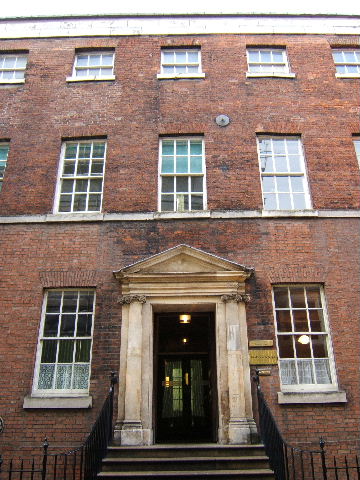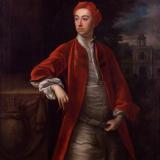Maister House, Hull
The building's sober facade hides one of the most fascinating interiors in the city; and a story of wealth, tragedy and high art.
The wealth belonged to the Maister family. The Maisters were one of a number of merchant families who lived on Hull's High Street and traded with ports around the North Sea and Baltic. The family originated in Kent and were first recorded in the parish register of Holy Trinity Church, Hull, in 1567.
During the following two centuries the Maisters enjoyed considerable success; family members held offices including Sheriff, Mayor and MP for Hull. It was during the time of one Henry Maister (1699-1744), who succeeded to the family business in 1716, that the great tragedy occurred.
On the night of 12-13 April 1743 the Maisters' family home caught fire. Henry Maister escaped the blaze, but his wife, Mary, youngest child and two maidservants did not. According to one account, Mary had initially fled the house with her husband but then returned and attempted to save her baby; it is believed that she became trapped on an upper floor of the burning building when the old wooden staircase collapsed.
The construction of the present Maister House was well underway by the winter of 1744. The new building was provided with stone staircases and iron balustrades - Henry Maister seems to have been determined to prevent the terrible events of the previous year ever recurring. But the new Maister House was much more than an exercise in fireproof construction; it was an expression of the most refined artistic taste of the day.
Henry Maister is known to have consulted Lord Burlington regarding the design of his new house. Richard Boyle (1694-1753), the 3rd Earl of Burlington (an old name for Bridlington) owned estates at Londesborough in East Yorkshire and was the greatest patron of the arts in early eighteenth century England. Burlington loved music and supported England's early opera houses; the composer George Frideric Handel (1685-1759) lived in the Earl's London home, Burlington House, for three years.
Burlington's greatest enthusiasm was for architecture: he himself designed Chiswick House, London, and The Assembly Rooms, York, but it was the Bridlington born painter and architect, William Kent (1685-1748), who was able to realise the Earl's most sophisticated designs. Burlington had met Kent in Vicenza where they studied the work of the renaissance architect Andrea Palladio (1508-81).
Although Palladio's work had been known in England since the early seventeenth century, it was through Lord Burlington's efforts in the early eighteenth century that "Palladianism" became the dominant style in the country. Burlington commissioned an English translation of Palladio's treatise I Quattro Libri dell' Architettura from the architect Isaac Ware (d. 1766) which was published as The Four Books of Architecture in 1738. The archetypal English country house often owes much to Ware's engravings of Palladio's north Italian villas. Palladio's designs combined simple geometric forms with elements derived from his study of ancient Roman remains. For eighteenth century architects, Palladio was an antidote to the florid baroque style of the previous generation; his methods also encouraged the growth of the science of archaeology.
No professional architect was employed in the building of Maister House. While Henry Maister stayed in Bath, the work was overseen by his youngest brother, Nathaniel (1703-72), and "Musgrave" who appears to have been a senior craftsman.
The exterior of Maister House appears very plain compared to the surrounding buildings on High Street; this simplicity is a typical feature of Palladian architecture. The facade is three storeys high with regularly spaced sash windows. The two bands of pale stone amongst the red brick are intended to imply the position and proportion of classical columns between the windows. The most decorative external element is the doorcase which is to a design by William Kent. Behind the front door a short passage leads to the principal glory of the house: the staircase.
The stairwell is a square space rising through the full height of the building. A broad staircase runs around three walls connecting the ground floor with the first floor landing. A gallery (reached by a hidden stair) runs around the stairwell at second floor level, above this daylight enters through an octagonal lantern. Whilst the walls of the stairwell are relatively plain, the ceilings, including the underside of the gallery, are richly decorated with stucco plaster.
The stucco was designed and executed by John Page. Many of the ornaments derive from ancient sources; these include the geometric "Greek key" and wave patterns and the scrolly acanthus leaves. Other ornaments are derived from nature and include seashells, rose buds, oak leaves and acorns. There is an emphasis on symmetry; but close inspection of the underside of the gallery will reveal slight variations from one section to another.
The delicate wrought-iron balustrade to the stairs and gallery are the work of Robert Bakewell (d. 1752) of Derby. On the wall above the stairs is a niche containing a statue of Ceres, the goddess of the harvest, by Cheere and on the opposite wall is a plaque representing the philosopher John Locke.
The ground floor of Maister house was always used for the business while the family occupied the upper floors (these rooms are not usually open to the public). The decoration of these rooms was incomplete when Henry Maister died in December 1744; the work was continued by his brother and his fourteen year old son, also Henry.
Colonel Henry Maister (1730-1812) (whose title came from his position in the East Yorkshire Militia) and his wife occupied Maister House from 1760; his portrait now hangs in the stairwell. The couple died childless and the house passed to the Colonel's nephews who preferred to live in the country. Rooms in Maister House were let as offices to various companies; the Maisters own business went into decline and by 1880 the whole building was taken over by Keighley, Maxsted & Co., corn merchants and has remained as offices ever since. During the nineteenth century, extensions were made at the rear of the building and a pair of bay windows were added to the front. After bomb damage, sustained during the Second World War, a flat roof was substituted for the original tiled pitched roof.
The National Trust acquired Maister House in 1966 and undertook a programme of restoration under the direction of architect Francis Johnson (1911-95). The bay windows were removed and the glazing returned to its eighteenth century appearance. The present stone steps and railings at the front entrance were designed by Mr. Johnson in a Georgian style.
Maister House is now occupied by the long established firm of architects, Gelder & Kitchen. The staircase is open to the public during office hours.
(Essay by Austen Redman first published on the BBC website in 2007)
In this section
- The Georgians
- Georgian Architecture in East Yorkshire
- Georgian Art, Literature & Music in East Yorkshire
- Georgian Science, Industry & Commerce in East Yorkshire
- Georgian Politics, Diplomacy & War
Related Products
See also
Related News
- Restored Coffin Plates unveiled at Londesborough.
- Event to Celebrate the Life of the 1st & 3rd Earls of Burlington.
- Hull History Centre receives award to catalogue Francis Johnson Archive

 Francis Johnson in 1972
Francis Johnson in 1972 The 3rd Earl of Burlington
The 3rd Earl of Burlington-2.jpg) Francis Johnson Maister House Drawing
Francis Johnson Maister House Drawing

